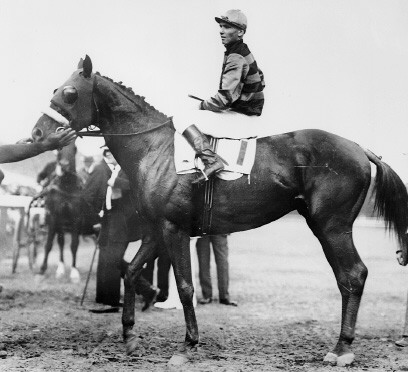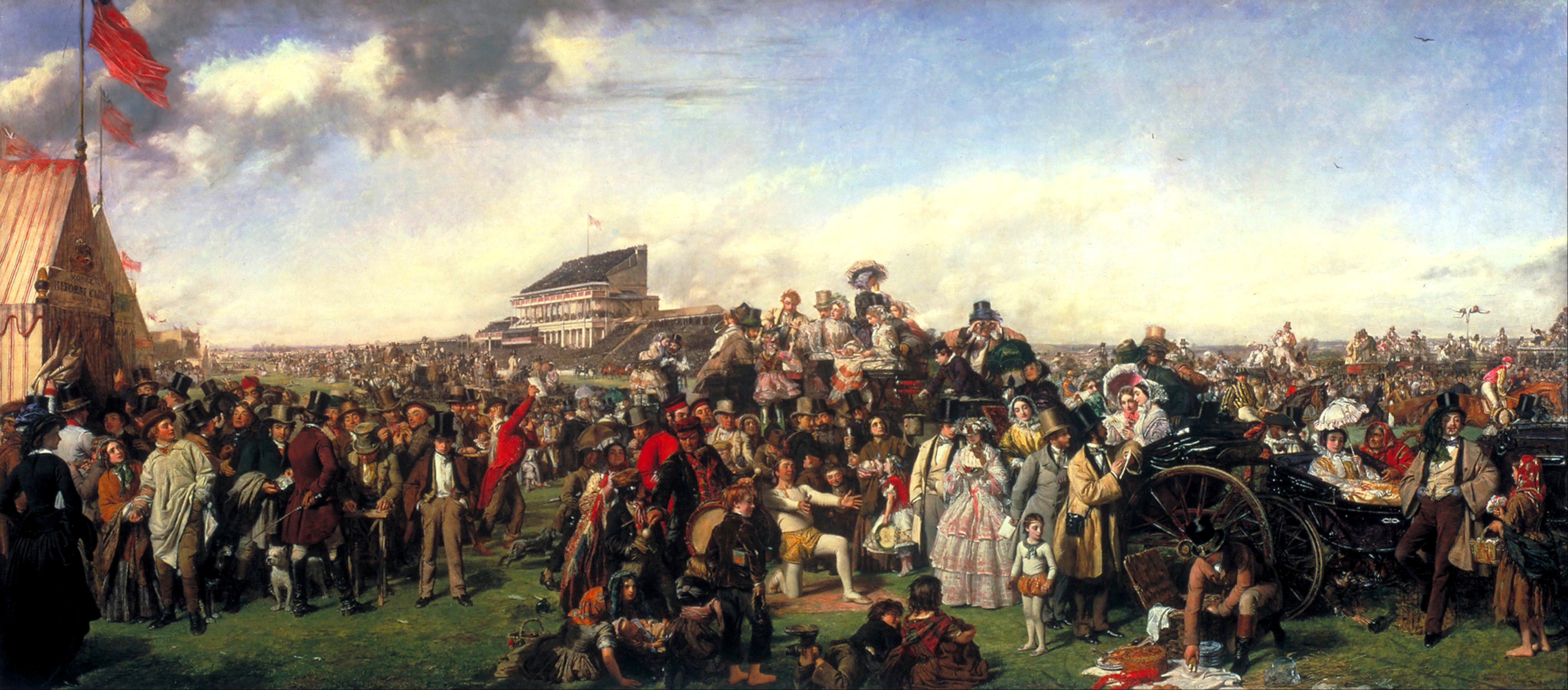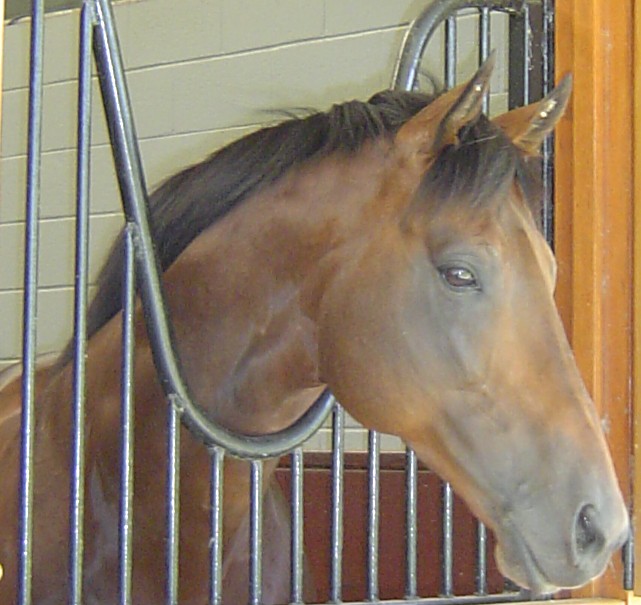|
Peter Pan I
Peter Pan (1904–1933) was an American Thoroughbred racehorse and sire, bred and raced by prominent horseman, James R. Keene. As winner of the Belmont Stakes, the Brooklyn Derby and the Brighton Handicap, he was later inducted into the National Museum of Racing and Hall of Fame. His progeny included many famous American racehorses, including several winners of the Kentucky Derby and the Preakness Stakes. Background Bred and raced by prominent horseman, James R. Keene, Peter Pan was out of the mare Cinderella whose sire was Hermit, the 1867 winner of England's most important race, The Derby. Peter Pan was sired by Commando, a 1901 American Classic Race winner who in turn was a son of Domino, the American Horse of the Year of 1893. Peter Pan was conditioned by future Hall of Fame trainer James G. Rowe Sr. Racing career At age 2, Peter Pan won four of his eight starts including the prestigious 1906 Hopeful Stakes. In 1907, Peter Pan won six of his nine starts with ... [...More Info...] [...Related Items...] OR: [Wikipedia] [Google] [Baidu] |
American Champion Three-Year-Old Male Horse
The American Champion Three-Year-Old Male Horse is an American Thoroughbred horse racing honor awarded annually in Thoroughbred flat racing. It became part of the Eclipse Awards program in 1971. The award originated in 1936 when ''Turf & Sports Digest'' (TSD) and ''Daily Racing Form'' (DRF) began naming an annual champion. Starting in 1950, the Thoroughbred Racing Associations (TRA) began naming its champion. The following list provides the name of the horses chosen by these organizations. The only disagreement came in 1968, when Turf & Sports Digest named Forward Pass as champion whereas the other two organizations voted for Stage Door Johnny. Champions from 1871 through 1935 were selected retrospectively by a panel of experts as published by ''The Blood-Horse magazine ''The Blood-Horse'' (also referred to simply as ''Blood-Horse'' and displayed on its nameplate in upright all-capital letters without hyphenation as BLOODHORSE) is a news magazine that originated in 1916 as a mo ... [...More Info...] [...Related Items...] OR: [Wikipedia] [Google] [Baidu] |
American Classic Races
In the United States, the Triple Crown of Thoroughbred Racing, commonly known as the Triple Crown, is a series of horse races for three-year-old Thoroughbreds, consisting of the Kentucky Derby, Preakness Stakes, and Belmont Stakes. The three races were inaugurated in different years, the last being the Kentucky Derby in 1875. The Triple Crown Trophy, commissioned in 1950 but awarded to all previous winners as well as those after 1950, is awarded to a horse who wins all three races and is thereafter designated as a Triple Crown winner. The races are traditionally run in May and early June of each year, although global events have resulted in schedule adjustments, such as in 1945 and 2020. The first winner of all three Triple Crown races was Sir Barton in 1919. Some journalists began using the term ''Triple Crown'' to refer to the three races as early as 1923, but it was not until Gallant Fox won the three events in 1930 that Charles Hatton of the ''Daily Racing Form'' put the ... [...More Info...] [...Related Items...] OR: [Wikipedia] [Google] [Baidu] |
Epsom Derby
The Derby Stakes, more commonly known as the Derby and sometimes referred to as the Epsom Derby, is a Group races, Group 1 flat Horse racing, horse race in England open to three-year-old Colt (horse), colts and Filly, fillies. It is run at Epsom Downs Racecourse in Surrey on the first Saturday of June each year, over a distance of one mile, four furlongs and 10 yards (2,423 metres) or about 1½ miles. It was first run in 1780. It is Britain's richest flat horse race and the most prestigious of the five British Classic Races, Classics. It is sometimes referred to as the "Blue Riband" of the turf. The race serves as the middle leg of the historically significant Triple Crown of Thoroughbred Racing#English Triple Crowns, Triple Crown of British horse racing, preceded by the 2000 Guineas Stakes, 2000 Guineas and followed by the St Leger Stakes, St Leger, although the feat of winning all three is rarely attempted in the modern era due to changing priorities in racing and breed ... [...More Info...] [...Related Items...] OR: [Wikipedia] [Google] [Baidu] |
England
England is a Countries of the United Kingdom, country that is part of the United Kingdom. It is located on the island of Great Britain, of which it covers about 62%, and List of islands of England, more than 100 smaller adjacent islands. It shares Anglo-Scottish border, a land border with Scotland to the north and England–Wales border, another land border with Wales to the west, and is otherwise surrounded by the North Sea to the east, the English Channel to the south, the Celtic Sea to the south-west, and the Irish Sea to the west. Continental Europe lies to the south-east, and Ireland to the west. At the 2021 United Kingdom census, 2021 census, the population was 56,490,048. London is both List of urban areas in the United Kingdom, the largest city and the Capital city, capital. The area now called England was first inhabited by modern humans during the Upper Paleolithic. It takes its name from the Angles (tribe), Angles, a Germanic peoples, Germanic tribe who settled du ... [...More Info...] [...Related Items...] OR: [Wikipedia] [Google] [Baidu] |
Mare (horse)
A mare is an adult female horse or other equine. In most cases, a mare is a female horse over the age of three, and a filly is a female horse three and younger. In Thoroughbred horse racing, a mare is defined as a female horse more than four years old. The word can also be used for other female equine animals, particularly mules and zebras, but a female donkey is usually called a "jenny". A ''broodmare'' is a mare used for breeding. Reproductive cycle Mares carry their young (called foals) for approximately 11 months from conception to birth, the average range being 320–370 days.Ensminger, M. E. ''Horses and Horsemanship: Animal Agriculture Series.'' Sixth Edition. Interstate Publishers, 1990. p. 156 Usually just one young is born; twins are rare. When a domesticated mare foals, she nurses the foal for at least four to six months before it is weaned, though mares in the wild may allow a foal to nurse for up to a year. The estrous cycle, also known as "season" or " ... [...More Info...] [...Related Items...] OR: [Wikipedia] [Google] [Baidu] |
1907 Brighton Handicap
Nineteen or 19 may refer to: * 19 (number) * One of the years 19 BC, AD 19, 1919, 2019 Films * ''19'' (film), a 2001 Japanese film * ''Nineteen'' (1987 film), a 1987 science fiction film * '' 19-Nineteen'', a 2009 South Korean film * '' Diciannove'', a 2024 Italian drama film informally referred to as "Nineteen" in some sources Science * Potassium, an alkali metal * 19 Fortuna, an asteroid Music * 19 (band), a Japanese pop music duo Albums * ''19'' (Adele album), 2008 * ''19'', a 2003 album by Alsou * ''19'', a 2006 album by Evan Yo * ''19'', a 2018 album by MHD * ''19'', one half of the double album '' 63/19'' by Kool A.D. * ''Number Nineteen'', a 1971 album by American jazz pianist Mal Waldron * ''XIX'' (EP), a 2019 EP by 1the9 Songs * "19" (song), a 1985 song by British musician Paul Hardcastle * "Stone in Focus", officially "#19", a composition by Aphex Twin * "Nineteen", a song from the 1992 album ''Refugee'' by Bad4Good * "Nineteen", a song from the 2 ... [...More Info...] [...Related Items...] OR: [Wikipedia] [Google] [Baidu] |
Preakness Stakes
The Preakness Stakes is an American thoroughbred horse race held annually on Armed Forces Day, the third Saturday in May at Pimlico Race Course in Baltimore, Maryland (except in 2026 when it will move to Laurel Park (race track), Laurel Park during reconstruction of Pimlico). The Preakness Stakes is a Graded stakes race, Grade I race run over a distance of on dirt. Colt (horseracing), Colts and geldings carry ; filly (horseracing), fillies . It is the second jewel (or leg) of the Triple Crown of Thoroughbred Racing (United States), Triple Crown, held two weeks after the Kentucky Derby and three weeks before the Belmont Stakes. First run in 1873, the Preakness Stakes was named by a former Maryland governor after the colt who won the first Dinner Party Stakes at Pimlico. Annual "Preakness Weekend" races include both the Saturday Preakness Stakes and a Graded stakes race, Grade II race on Friday for fillies only named the Black-Eyed Susan Stakes. Attendance at the Preakness Stakes ... [...More Info...] [...Related Items...] OR: [Wikipedia] [Google] [Baidu] |
Kentucky Derby
The Kentucky Derby () is an American Graded stakes race, Grade I stakes Thoroughbred racing, race run at Churchill Downs in Louisville, Kentucky. The race is run by three-year-old Thoroughbreds at a distance of . Colt (horse), Colts and geldings carry and fillies . Held annually on the first Saturday in May, the Derby is the first leg of the Triple Crown of Thoroughbred Racing (United States), Triple Crown. It is preceded by the two-week-long Kentucky Derby Festival. The race is known as "The Run for the Roses", as the winning horse is draped in a blanket of roses. Lasting approximately two minutes, the Derby has been alternately called "The Most Exciting Two Minutes in Sports", "The Fastest Two Minutes in Sports", or "The Greatest Two Minutes in Sports", coined by Churchill Downs president Matt Winn. At least two of these descriptions are thought to be derived from the words of sportswriter Grantland Rice, when in 1935 he said "Those two minutes and a second or so of derby ru ... [...More Info...] [...Related Items...] OR: [Wikipedia] [Google] [Baidu] |
Horse Breeding
Horse breeding is reproduction in horses, and particularly the human-directed process of selective breeding of animals, particularly purebred horses of a given Horse breed, breed. Planned matings can be used to produce specifically desired characteristics in domestication, domesticated horses. Furthermore, modern breeding management and technologies can increase the rate of conception, a healthy pregnancy, and successful foaling. Terminology The male parent of a horse, a Stallion (horse), stallion, is commonly known as the ''sire'' and the female parent, the mare (horse), mare, is called the ''dam''. Both are genetically important, as each parent's genes can be existent with a 50% probability in the foal. Contrary to popular misuse, "colt" refers to a young male horse only; "filly" is a young female. Though many horse owners may simply breed a family mare to a local stallion in order to produce a companion animal, most professional breeders use selective breeding to produce ... [...More Info...] [...Related Items...] OR: [Wikipedia] [Google] [Baidu] |
Horse Racing
Horse racing is an equestrian performance activity, typically involving two or more horses ridden by jockeys (or sometimes driven without riders) over a set distance for competition. It is one of the most ancient of all sports, as its basic premise – to identify which of two or more horses is the fastest over a set course or distance – has been mostly unchanged since at least classical antiquity. Horse races vary widely in format, and many countries have developed their own particular traditions around the sport. Variations include restricting races to particular breeds, running over obstacles, running over different distances, running on different track surfaces, and running in different gaits. In some races, horses are assigned different weights to carry to reflect differences in ability, a process known as handicapping. While horses are sometimes raced purely for sport, a major part of horse racing's interest and economic importance is in the gambling associated ... [...More Info...] [...Related Items...] OR: [Wikipedia] [Google] [Baidu] |
Thoroughbred
The Thoroughbred is a list of horse breeds, horse breed developed for Thoroughbred racing, horse racing. Although the word ''thoroughbred'' is sometimes used to refer to any breed of purebred horse, it technically refers only to the Thoroughbred breed. Thoroughbreds are considered "Hot-blooded horse, hot-blooded" horses that are known for their agility, speed, and spirit. The Thoroughbred, as it is known today, was developed in 17th- and 18th-century England, when native mares were Crossbreed, crossbred with imported stallion (horse), stallions of Arabian horse, Arabian, Barb horse, Barb, and Turkoman horse, Turkoman breeding. All modern Thoroughbreds can trace their pedigrees to three stallions originally imported into England in the 17th and 18th centuries, and to a larger number of foundation bloodstock, foundation mares of mostly English breeding. During the 18th and 19th centuries, the Thoroughbred breed spread throughout the world; they were imported into North America ... [...More Info...] [...Related Items...] OR: [Wikipedia] [Google] [Baidu] |








